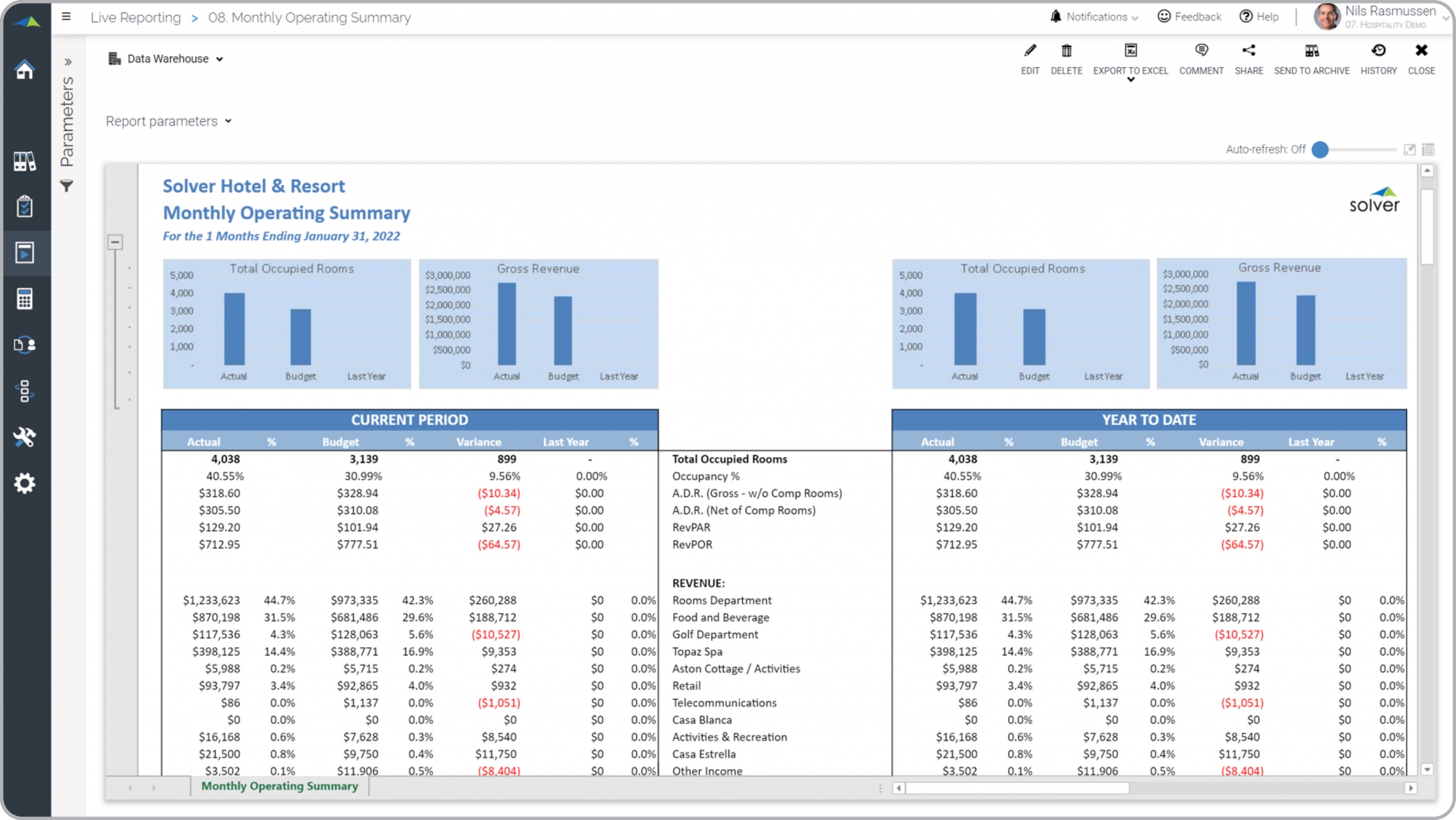Monthly Operating Summary Report for a Hospitality Company
What is
a
Monthly Operating Summary Report
? Operating Summary Reports are considered business- and departmental analysis tools and are used by financial managers and executives to analyze key metrics, revenues and profitability. Some of the main functionality in this type of report is that it combines KPIs with financial summaries. The top of the report shows charts with Total Occupied Rooms and Revenue for monthly and year-to-date (YTD) figures. The top section with figures shows KPIs with actual, budget, last year and variances. The next two sections show revenue and profitability (not visible in the screenshot below) by department. The bottom of each section shows the company-level total revenue and profit. You find an example of this type of report below.
Purpose of Monthly
Operational Summary Reports Hospitality companies use Operational Summary Reports to provide managers with a combined departmental and summary view of the company's top metrics. When used as part of good business practices in Executive- and FP&A departments, a company can improve its operational tactics and profitability, and it can reduce the chances that leaders don't have a convenient way to see the relationship between department and company revenue and profitability.
Example of an
Operational Summary Report Here is an example of an Operational Summary Report with monthly and YTD charts and KPIs. [caption id="" align="alignnone" width="2560"]
 Example of a Monthly Operating Summary Report for a Hospitality Company[/caption] You can find hundreds of additional examples
here
Who Uses This Type of
Report
? The typical users of this type of report are: CFOs, analysts, budget managers, department managers.
Other Reports Often Used in Conjunction with
Operational Summary Reports Progressive Executive- and FP&A departments sometimes use several different Operational Summary Reports, along with company financial statements, department P&L's, forecast models, budgets, KPI scorecards and other management and control tools.
Where Does the Data for Analysis Originate From? The Actual (historical transactions) data typically comes from enterprise resource planning (ERP) systems like: Microsoft Dynamics 365 (D365) Finance, Microsoft Dynamics 365 Business Central (D365 BC), Microsoft Dynamics AX, Microsoft Dynamics NAV, Microsoft Dynamics GP, Microsoft Dynamics SL, Sage Intacct, Sage 100, Sage 300, Sage 500, Sage X3, SAP Business One, SAP ByDesign, Acumatica, Netsuite and others. In analyses where budgets or forecasts are used, the planning data most often originates from in-house Excel spreadsheet models or from professional corporate performance management (CPM/EPM) solutions.
What Tools are Typically used for Reporting, Planning and Dashboards? Examples of business software used with the data and ERPs mentioned above are:
Example of a Monthly Operating Summary Report for a Hospitality Company[/caption] You can find hundreds of additional examples
here
Who Uses This Type of
Report
? The typical users of this type of report are: CFOs, analysts, budget managers, department managers.
Other Reports Often Used in Conjunction with
Operational Summary Reports Progressive Executive- and FP&A departments sometimes use several different Operational Summary Reports, along with company financial statements, department P&L's, forecast models, budgets, KPI scorecards and other management and control tools.
Where Does the Data for Analysis Originate From? The Actual (historical transactions) data typically comes from enterprise resource planning (ERP) systems like: Microsoft Dynamics 365 (D365) Finance, Microsoft Dynamics 365 Business Central (D365 BC), Microsoft Dynamics AX, Microsoft Dynamics NAV, Microsoft Dynamics GP, Microsoft Dynamics SL, Sage Intacct, Sage 100, Sage 300, Sage 500, Sage X3, SAP Business One, SAP ByDesign, Acumatica, Netsuite and others. In analyses where budgets or forecasts are used, the planning data most often originates from in-house Excel spreadsheet models or from professional corporate performance management (CPM/EPM) solutions.
What Tools are Typically used for Reporting, Planning and Dashboards? Examples of business software used with the data and ERPs mentioned above are:
- Native ERP report writers and query tools
- Spreadsheets (for example Microsoft Excel)
- Corporate Performance Management (CPM) tools (for example Solver)
- Dashboards (for example Microsoft Power BI and Tableau)
Corporate Performance Management (CPM) Cloud Solutions and More Examples
August 12, 2021
TAGS:
Reporting,
Solver,
report writer,
Microsoft,
golf,
template,
practice,
Acumatica,
hospitality,
expenses,
Netsuite,
Finance,
Profit and Loss,
planning,
GP,
Business Central,
excel,
restaurant,
resort,
spa,
ax,
hotel,
income statement,
forecast,
Budget,
Dynamics 365,
analysis,
budgeting,
KPI,
revenue,
Cloud,
Software,
casino,
Tableau,
SAP,
example,
best,
Sage,
BC,
P&L,
D365,
NAV,
Intacct,
Variance,
GL,
CPM,
report,
SL,
Management,
dynamics,
Power BI,
operating summary,
flash report

